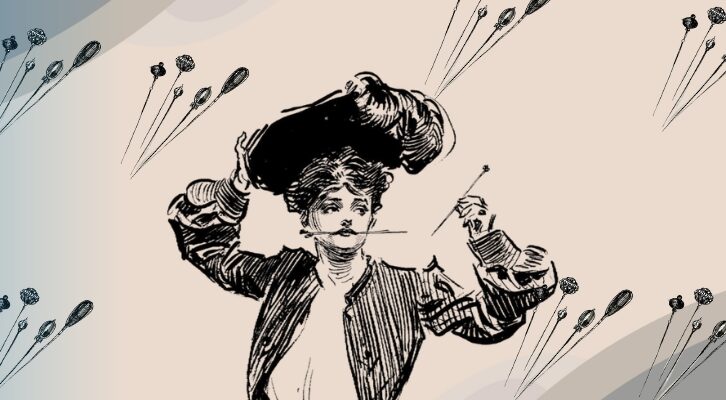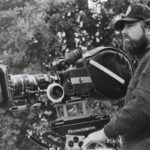
When Andre Agassi Made Me a Woman (and a Writer)
Marie-Helene Bertino on the Literary Life Lessons of the Hardcourt
When I was ten years old, my father took me into Center City Philadelphia to attend my first tennis match. The trip was a reward for winning a junior tournament and my innaugural visit to what I thought was a professional tennis stadium. The Spectrum was usually a hockey rink but that day it had rubber carpets rolled over the ice to form courts. Its overall effect was compact, intoxicating intimacy.
We found our seats and the players entered. One of them—short for a tennis player, with long, blondish hair—emerged, no, sprang from the underground locker room where he had no doubt bobbed in place, impatient to begin. In one seamless movement, he sprint-walked to his designated chair, unsheathed his racquet and tested it with a few quick swipes across the stilted air. His charm was beyond physical. He seemed deeply alive.
As if triggered by his will, the match began.
He commanded attention even when doing nothing more sultry than walking the baseline in small, shuddering steps. When he didn’t like a call, he said so. Within a few games, the crowd realized that he expected our participation. A palpable restlessness flirted around his figure that felt big enough to include us. So we began to talk to him. That call was suspect, we’d say. We whistled, tennis etiquette for bullshit.
After a scorcher down the line was called out, he consulted us with a raised eyebrow. You didn’t like that one, either, huh? He leapt onto the stubby wall that separated him from us, and raised his racquet like She-ra, I would have thought at the time. He brought his racquet to the right, then to the left, then again. He wanted us to do it, too. We repeated his “wave” in our racquetless hands as he added a chant. We chanted with him. Nooooooo.
This was before Barbra Streisand and Brooke Shields. Before the wrist injury. Even before he began to wear the neon garb that garnered worldwide penalties. That day, Andre Agassi wore a simple white polo shirt and denim shorts. He was 18.
Antics like his were unheard of and frowned upon by umpires. He lost the point. But he had won (whisper it) our hearts.
Driving home, I replayed film of him in my head. The feathery, tri-colored hair. The denim racquet bag with yellow-lime piping. An ache bloomed in my lower belly as we pulled into the driveway, growing stronger as my father gave a cursory account of our day to my mother, who stood semi-patiently in the doorway, waiting for him to leave.
I had been learning the game on the city’s hard courts, in a new program called the National Junior Tennis League (NJTL), whose mission was to bring tennis to under-resourced youth. I didn’t know I was under-resourced. But I knew how to make a short ball brush the line before zagging out of bounds, a question few other ten-year-olds could answer.
My father drove away and I retreated into the small bathroom we all shared. In my underwear I found a bright shock of blood. A first.
What I’m saying: Andre Agassi ushered me into womanhood.
Last month, my husband and I watched Serena Williams beat Venus Williams in the quarterfinals of the U.S. Open.
Where is her help? He said, when Serena lugged her stuff on and off the court. Where is her coach?
They bring everything in and take everything out themselves. Their coach is in the crowd with everyone else.
He says, It looks so lonely.
* * * *
Two years after the Agassi match, silmultaneously naïve and streetwise, I tried out for the tennis team of a suburban high school on one of those mornings so early they steam. The girls flanking me wore white polo shirts and white tennis skirts with built-in pockets. Their legs were tanned in a way that exuded temporariness, a championing of dark skin that began on Memorial Day and ended on Labor Day.
I wore an oversized fluorescent pink tee shirt and shorts, the way Andre did. I wore a gold chain around my neck with a tennis racquet charm, the way he did. My racquet bag was denim with neon piping and held the body of my beloved Donnay wide-body, the brand he shilled. I prowled the baseline in small, shuddering steps, glaring into my strings. Offered a lob, I decimated it. Afterward it was not unusual for me to whisper a TJ Hooker-esque one-liner, the way I thought he would. Is that all you got for me? And I thought it was going to be a tough day.
“What is the image of a rebel?” Andre asks in a Canon camera commercial from that time. Bathed in golden light, he doffs his shirt and throws it at the camera.
I rowred at my reflection in my teenaged bedroom: I AM.
My color was permanent, my features were (my mother assured me) exotic. A spray of acne on my forehead, a swipe of Debbie Gibson’s Electric Youth perfume on my pulse. Our backgrounds peeked out from places our uniforms couldn’t cover; in hair styles, accents, watches, jewelry, how you danced, how you pronounced words like water and home. I was too young to know it, but even the way I played the game said city girl, poor girl. Playing as a two handed baseliner signified that you learned the sport on the speedy, unrelenting surface of a hard court. The girls who learned the game at country clubs had access to softer courts like clay and grass that allowed for the delicate, nuanced play of a serve and volleyer. Think Bjorn Bjorg, delivering the ball like a gentleman delivers a coaster to buffet your drink. I say, chap, would you mind if I placed this volley in an area of the court unreachable by even your admittedly capable stride? Much obliged.
The chief characteristic of Agassi’s game—and it follows, mine—was a new obsession with hitting on the rise. This meant returning the ball after the bounce but before it had reached its highest trajectory, when its internal momentum, its ambition, could most effectively count against it. This caught opponents in half-step, not yet comfy in their ready positions. David Foster Wallace called this shot the one Agassi dined out on.
I made the tennis team at that elite high school and was assigned to first doubles, rare for a freshman. I got to know my fellow teammates in the tennis skirts, who were funny and down-to-earth. They taught me how to carve subtle points out at the net and I taught them a city girl’s currency: comebacks and hip-hop dancing. You wish, they’d say when they’d slam an overhead into the unreturnable vicinity of their opponent’s ankles. Keep walking.
* * * *
Singles tennis, like writing, is a solitary pursuit. This suits those of us who don’t like relying on or disappointing partners. My failures are my own, and I like that. It follows that my successes are too, though I don’t think about them as much.
My childhood playing tennis lies dormant in me, an unused language. In my direst creative moments, when I am certain I am the most abject of fools, equipping techniques from tennis reoccur.
Good outlook begets good results. When you are at your lowest, it behooves you to keep positive. Anger would occasionally vault players like John McEnroe and Agassi off their games, distracting them so much they were unable to recapture focus. The tennis player, like the writer, must cultivate and maintain a personal practice, capable of saving itself if one part begins to flag. In tennis, this framework is made out of not only mental outlook but physical gestures between points that are practiced as often as serves. Gazing up while walking the baseline instead of down at the mutinous strings that failed you. Swallowing a tough call instead of fighting.
Many players perform the same, idiosyncratic ritual before service. Rafael Nadal, for example, refuses exactly one ball, kicks out his right foot, adjusts the back of his shorts, and swipes purposefully at his (usually perfect) hair before tossing the ball for service. Some players take the same amount of steps when they switch sides to return service. Andre wore the same triangle earring during every match. Father, son, holy ghost.
Once in a while, a ball taps the net mid-point and hovers in air. Both players enter a slow motion stasis (The Matrix) until the ball decides its favor. It is a magic trick of tennis that the ball normally drops on the side of the player whose mental game is slipping.
There are similar magic tricks in fiction that favor those in constant practice. The way a line explodes into something greater than its parts, something greater than your stumbling writer brain could ever have planned, when you take a phrase out, rather than add.
The lines on the court, on the page. Even if they can’t always be your friend, constant practice makes them friendlier. Begets, begets, begets.
These rituals make up a metaphysical assembly line—without thought but mindful—so when the mental game derails, players/writers can use the consistency of the physical one to reenter a Place of Total Focus. These rituals are also ecstatic, meant to produce a portal through which players/writers may transcend their mortal limits.
The writer I know who can only write in the morning. Who can write only at night, after the kid is asleep. Only after one and a half cups of coffee. Only after the mail has arrived. Only until the mail has arrived. Only when accompanied by a glass of neat Scotch, one’s loyal mutt, the TLC documentary Crazy Sexy Cool on mute, The Goldberg Variations.
* * * *
To my surprise, the girls I played tennis with in high school did so because they knew how, not because of any insatiable need. In college, they planned to pursue practical fields like nursing and economics.
My tennis coach outlined a future in which I received a tennis scholarship to an area college. It wouldn’t take much, she said, just practicing every morning before regular practice. I had already acted in my first play and had fallen in love with theater, an activity that was defined not by how solitary you were but by how many people surrounded you. In college, I planned to pursue the practical field of Creative Writing.
No thanks, I said. And I quit.
* * * *
This began what I call the cigarettes-for-breakfast years. After college I moved to New York and the distractions of being in my twenties took over. It felt good to smoke cigarettes, stay up late drinking whiskey with friends, and spend most of the next day staring out of gritty windows, feeling dramatic. My writing reflected this behavior. It existed in short, dirty bursts, drowning in self.
I still followed Andre’s career and my favorite pastime became John McEnroe-commentated Andre matches, when the men’s obvious friendship shone through. Both players were known for their on-court passion, and McEnroe knew things about Andre that no other commentator could. During one match McEnroe ticked off a list of Andre’s positive attributes and then, unable to contain his admiration, squealed, Just look at his chest! I’d catch a match here and there, feeling guilty that I no longer knew who the up-and-comers were, until eventually I stopped doing even that.
* * * *
On September 3rd, 2006, Andre faced Benjamin Becker in his last U.S. Open. From the beginning of Andre’s career, New Yorkers had recognized him as a kindred outspoken spirit and had, fittingly, let him know during every match he played there. A few train stops away in my apartment in Queens, I watched Becker serve for the match at 6-5 in the fourth set. A 135 mph smoker aced the best returner of serve in the history of the game, and Andre’s career was over. As he received a four-minute standing ovation, I led my own in my Queens apartment, feeling like I was watching a childhood friend drive to a new home.
I had been writing short stories, but a longer project had crashed several times. I didn’t possess the level of concentration required to comb through so many pages and divine what should be salvaged or jettisoned.
I started a job as a biographer of people living with traumatic brain injury. Most had been injured in car accidents or on the job and many could no longer run, exercise or, in some cases, walk. I began to feel guilty that my body was healthy and strong yet I rarely used it for anything more taxing than spreading margarine on a bagel.
On a writer’s residency in Puget Sound, I tried running. A few blocks at first then, over the course of the month, longer distances. My only audience were llamas from a nearby farm, which helped. They’d stare as I jerked by, their eyes sympathetic but non-judgemental. When I returned to New York I kept running outside, through cold and warm seasons. Muscles bloomed in my legs. Cigarettes suddenly seemed counterintuitive, so I quit them. Tennis and its lessons about repetition, self-motivation, self-reliance, and power, had lain dormant in me, and when it re-emerged, it did so as running.
Somewhere in the expanse of good and bad days, the nougat of immeasurable, unable-to-be-articulated middle distance where life resides, this: I knew I could write a novel. The consistent practice of running had triggered something in the writing.
There is precedent for messages conveyed from the physical to mental realms. Haruki Murakami famously recounted that when he watched Dave Hilton hit a double, he realized he could write a novel, that unlikely things are not only possible but are able to be self-generated. If I can run through a cramp on a mile-long hill, stride by stride, I can interrogate the lines on 300 pages, one by one. I can accomplish tasks as brain-achingly minute as retyping the entire manuscript twice. It’s not only about force, but force over time.
Endurance I build while regularly running bleeds easily into my writing practice, and to this day they exist hand in hand. When the writing isn’t going well, chances are the running isn’t either.
* * * *
Tennis taught me to carry my own bag in and out, how to congratulate an opponent when it isn’t my day, how to congratulate an opponent when it is. Andre taught me: The further into the true self you go, the less like everyone else you look. I work to put to route anything that distracts me from my game—this includes reviews (good or bad), social media, anger, jealousy. I’ve never wanted to be better than anyone else. I’ve only ever demanded enough room to be as much like myself as I possibly can.
A few years ago, Andre published a memoir. It seems he had ambivalent feelings about the sport that shaped his life. Pressured by his father’s expectations, he wasn’t always having a blast on the court. Even his hair turned out to be more complicated than it seemed (toupee). Rather than ruin my earlier devotion, his honesty cheered me. (More or less) an adult now, I appreciate this ambivalence. Who knows what he was going through that day, years ago, when he backhanded Veli Paloheimo out of the tournament and launched a girl’s relationship with physical and mental fortitude—and neon. External opponents ain’t shit. You can’t play as much tennis as I did and not know this: The toughest opponent you’ll ever encounter is a wall.
I walk to the baseline. I lift up my gaze.
Marie-Helene Bertino
Marie-Helene Bertino is the author of 2 A.M. at the Cat's Pajamas and the story collection Safe as Houses. She was the 2017 Frank O'Connor International Short Story Fellow in Cork, Ireland. Her work has received The O. Henry Prize, The Pushcart Prize, The Iowa Short Fiction Award, The Mississippi Review Story Prize, fellowships from MacDowell, Sewannee, and NYC's The Center for Fiction, and has twice been featured on NPR's Selected Shorts. Formerly the associate editor of One Story and Catapult, she now teaches at NYU, The New School, and Institute of American Indian Arts in Santa Fe.



















